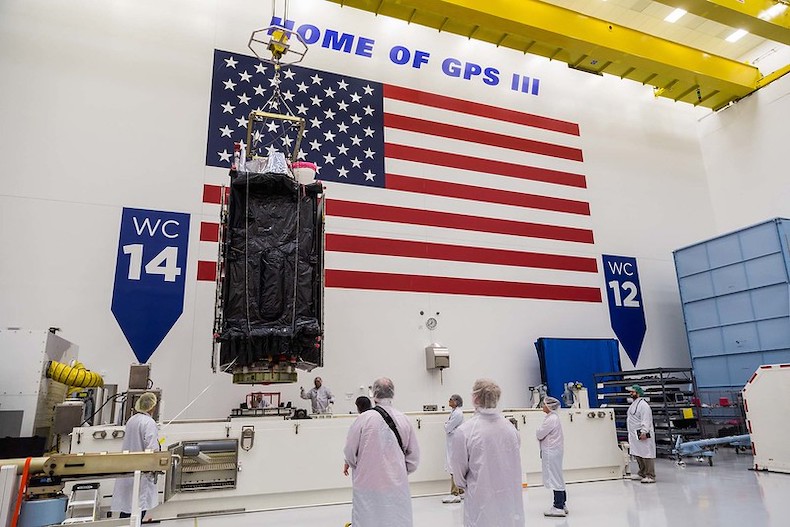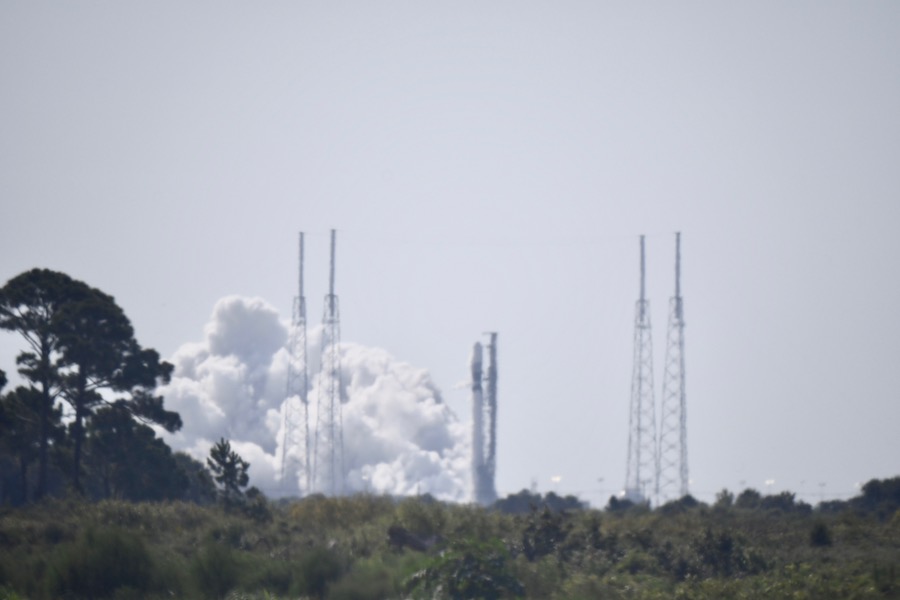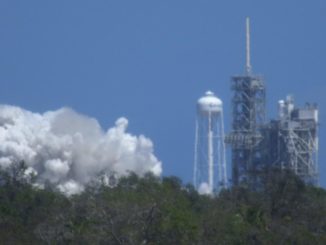
The U.S. military’s next GPS navigation satellite moved to a SpaceX launch facility late Thursday at Cape Canaveral, ready for attachment with a Falcon 9 rocket for liftoff June 30 to take the place of an aging GPS spacecraft launched from Florida’s Space Coast more than 20 years ago.
Built by Lockheed Martin, the spacecraft was closed up inside the payload shroud of its Falcon 9 rocket Sunday inside the Astrotech payload processing facility in Titusville, then trucked to Cape Canaveral Air Force Station late Thursday. Once in position inside a SpaceX rocket hangar, ground teams planned to mount the spacecraft and payload fairing to the Falcon 9 launcher that will carry the GPS satellite into orbit.
The third in the military’s new GPS 3-series of navigation satellites is scheduled for launch from Cape Canaveral’s Complex 40 launch pad during a 15-minute window opening at 3:55 p.m. EDT (1955 GMT) Tuesday, June 30.
The GPS 3 SV03 spacecraft follows the launch of SV01 and SV02 in December 2018 and August 2019. Those satellites launched on SpaceX Falcon 9 and United Launch Alliance Delta 4 rockets, respectively.
Both of the previous GPS 3-series satellites are healthy, according to the U.S. Space Force’s Space and Missile Systems Center. They were “set healthy” and officially entered the operational GPS constellation Jan. 13 and April 1, an SMC spokesperson said.
The GPS 3 SV03 satellite will launch into an elliptical transfer orbit aboard the Falcon 9 rocket. After deployment from the launch vehicle, the GPS satellite will use its own propulsion system to reach a circular orbit inclined 55 degrees to the equator at an altitude of about 12,550 miles (20,200 kilometers).
The launch June 30 is timed to place the GPS 3 SV03 spacecraft into Plane E, Slot 4 of the GPS constellation. That position is currently occupied by a GPS satellite launched May 10, 2000, from Cape Canaveral on a Delta 2 rocket. Military officials did not say whether that satellite, which was originally designed for a 10-year mission, will be decommissioned or moved to another slot in the GPS network.
@SpaceX @elonmusk #GPS3SV03 being transported to Kennedy Space Center ahead of Launch 🚀 The size is unbelievable pic.twitter.com/CAsMib4v9k
— SpaceGal (@_SpaceGal_) June 26, 2020
The GPS satellites are spread among six orbital planes, each with four primary spacecraft, plus spares.
The GPS network provides positioning and timing services worldwide for military and civilian users, beaming signals relied upon by airliners, ATMs, drivers and smart bombs, among numerous other users.
The GPS 3 satellites provide more accurate navigation signals and boasting longer design lifetimes of 15 years. The new GPS 3 satellites also broadcast e a new L1C civilian signal that is compatible with Europe’s Galileo network and Japan’s Quasi-Zenith Satellite System.
Other space-based navigation networks operated by Japan and China are also adopting similar compatible signals.
Like the previous line of Boeing-built GPS 2F satellites, all GPS 3-series spacecraft broadcast a dedicated L5 signal geared to support air navigation. The GPS 3 satellites also continue beaming an encrypted military-grade navigation signal known as M-code.
The M-code signal allows GPS satellites to broadcast higher-power, jam-resistant signals over specific regions, such as a military theater or battlefield. The capability provides U.S. and allied forces with more reliable navigation services, and could also allow the military to intentionally disrupt or jam civilian-grade GPS signals in a particular region, while the M-code signal remains unimpeded.
L3Harris Technologies builds the navigation payloads for the GPS 3 satellites.

The launch June 30 will be the first dedicated flight by SpaceX for the U.S. Space Force since the new military branch was established in December.
It comes four days after the scheduled launch Friday of a different Falcon 9 rocket from pad 39A at NASA’s Kennedy Space Center, a few miles to the north of pad 40. That mission was set to loft 57 satellites for SpaceX’s Starlink broadband Internet constellation, along with a pair of commercial Earth-imaging microsatellites for BlackSky.
SpaceX test-fired the Falcon 9 rocket assigned to the GPS launch Thursday, less than a day after a similar static fire test of the Falcon booster for the Starlink/BlackSky mission.
Unlike SpaceX’s launch of the first GPS 3-series satellite in 2018, military officials overseeing the flight have allowed SpaceX to set aside enough propellant reserve on the Falcon 9 booster to attempt a landing on an offshore drone ship in the Atlantic Ocean. SpaceX flew the Falcon 9 rocket in a fully expendable configuration for the GPS 3 SV01 launch in 2018.
Email the author.
Follow Stephen Clark on Twitter: @StephenClark1.



